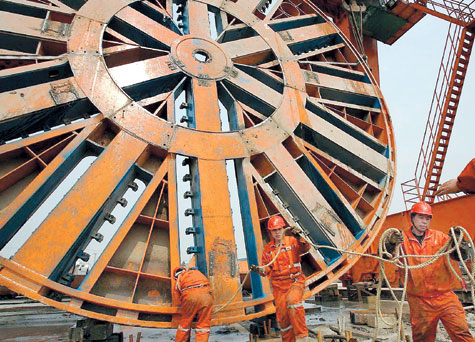Shanghai Daily news

Workers yesterday install an 85-ton shield for the construction of the Xizang
Road S. Tunnel across Huangpu River, which is being built to help traffic flow
for the Shanghai World Expo in 2010.
Shanghai is setting the benchmark for a clean and green city - with a little
help from the sun.
Solar energy will be used to provide the illumination
for a new tunnel across the Huangpu River, which will be in operation by
2010.
The tunnel light system will be the first of its kind on China's
mainland, project engineers said yesterday.
The Xizang Road S. Tunnel is
being built to streamline traffic flow for the World Expo in
2010.
Located in the center of the 5.28-square-kilometer Expo site
between the Nanpu and Lupu bridges, the tunnel will span 2.67 kilometers and
link Xizang Road S. in Puxi with Pudong Road S. on the river's eastern
bank.
"The purpose of using solar energy is energy conservation ... and
to advocate energy conservation for the world fair," said Pan Guoqing, an
engineer of Shanghai No.2 Municipal Engineering Company, the project
contractor.
In a preliminary plan, about 250 square meters of
solar-reception membranes, or panels, will be paved atop the two tunnel
entrances to absorb the sun's energy and transfer it into power for interior
illumination.
Major construction on the tunnel will start in the middle
of this year, but full details of the solar project haven't been decided,
engineers said. The overall cost of the tunnel project is not
known.
However, it is estimated that the single solar facility for the
tunnel, which may generate power capacity of 40 kilowatts per hour, will cost
four million yuan (US$500,000), the engineers said.
Solar power may
account for less than 10 percent of the tunnel's power consumption, with the
rest coming from conventional electricity supplies, they added.
Under
normal conditions, the solar power facility will have a shelf life of about 25
years.
The Shanghai government is covering all operation expenses for the
tunnel, including the solar power section.
The tunnel will incorporate
two tubes and four lanes.
City officials expect 70,000 people to cross
the Huangpu River every hour during the six months of World Expo.
Li
Jianjun, a professor of energy technology of the Shanghai Academy of Sciences,
said: "Though solar power accounts for a small amount of power in the tunnel, it
sets a good example to promote clean energy."
He said Shanghai has an
advantageous geographical location with regard to its average hours of
sunlight.
He also said solar power has been extensively used in Western
countries in urban construction. During the 2000 Sydney Olympics, for example,
solar energy was extensively used for stadium and residential
facilities.



